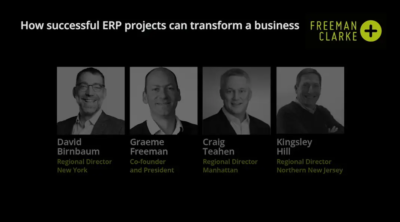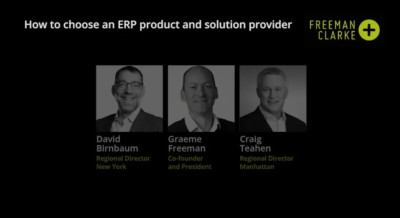Don’t run your business on Excel
Excel is incredibly popular, and with good reason: it's cheap, it's useful, and it's easy to use. You still shouldn't...
Read moreExcel is incredibly popular, and with good reason: it's cheap, it's useful, and it's easy to use. You still shouldn't...
Read moreWe’ve recorded a series of discussions with our ERP experts: Regional Director Christine Parker, Our Co-founder and director Graeme Freeman...
Read moreWe have recorded a series of informative discussions about ERP. Two of our Regional Directors (Christine Parker Stubbs and Victor...
Read moreIntegration challenges can be difficult to identify. In this video, Freeman Clarke Co-founder Graeme Freeman explains three of most common...
Read moreAt Freeman Clarke, clients frequently ask for our help with their Enterprise Resource Planning (ERP) projects. We’re not surprised, because...
Read moreFreeman Clarke co-founder Graeme Freeman explains the three areas you’ll need to focus on for a successful systems integration project....
Read moreLook around any office, and you’ll see people whose main work is dealing with systems and information. People organize information,...
Read moreAccording to McKinsey & Company, 60% of jobs could automate 30% of their tasks. Forrester, a respected technology research company,...
Read moreWe’ve recorded a series of discussions with our ERP experts: Regional Director Christine Parker, Our Co-founder and director Graeme Freeman...
Read morePlain English board-level briefings focused on technology strategies to deliver competitive advantage and business success.
You can unsubscribe at any time.
Call us on 0203 020 1864 with any questions.
Graeme Freeman
Co-Founder and Director
Plain English board-level briefings focused on technology strategies to deliver competitive advantage and business success.
You can unsubscribe at any time.
Call us on 0203 020 1864 with any questions.








